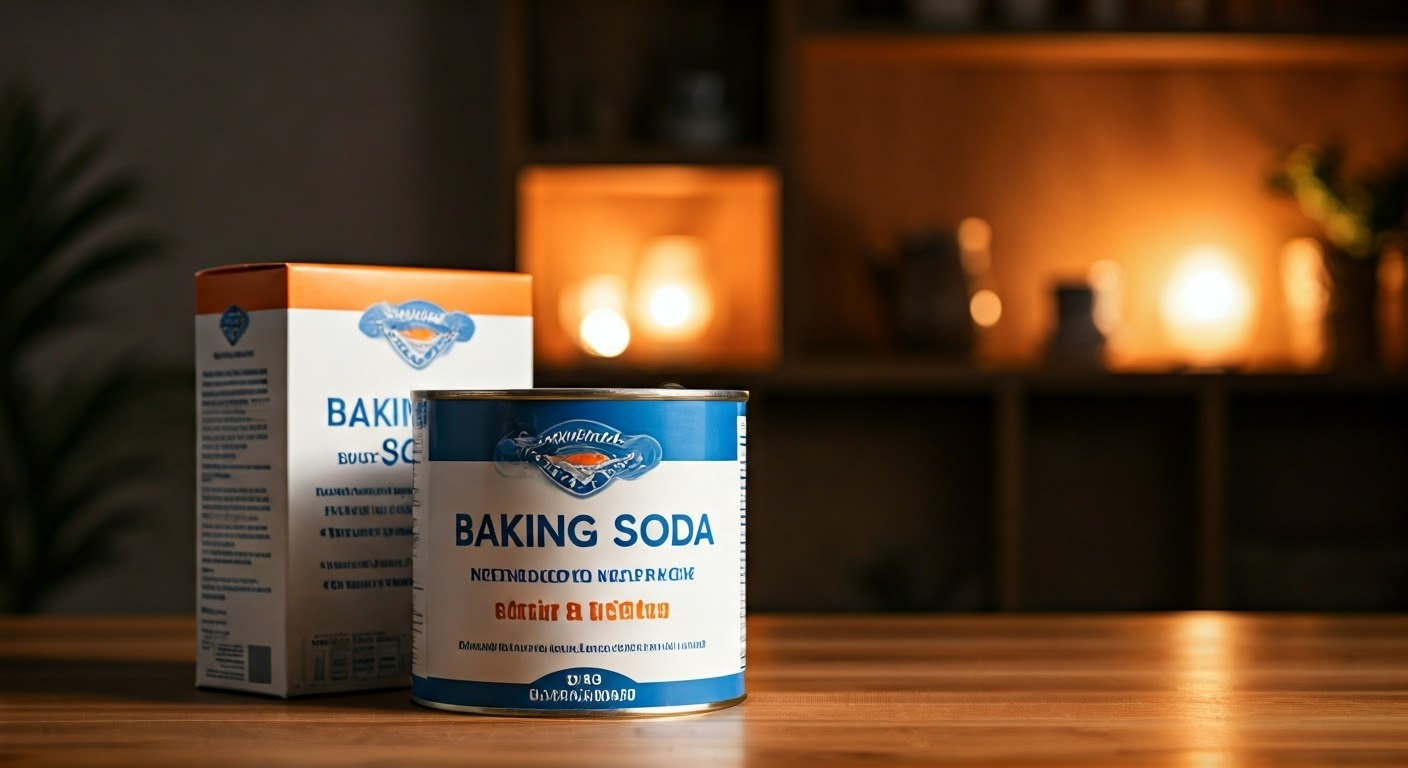
Giving your home a fresh look with a new coat of paint is exciting, but the accompanying paint fumes can be overwhelming.
These fumes are often caused by VOCs (Volatile Organic Compounds) released from paint, leading to a lingering paint smell.
Thankfully, a simple household ingredient like baking soda can effectively neutralize these odors and create a fresher living environment.
| Preview | Product | |
|---|---|---|

|
It's Just - Baking Soda, 100% Pure Sodium Bicarbonate,... | Check Price |

|
Arm & Hammer Baking Soda, 1 lb. | Check Price |
The Science Behind VOC Paint Fumes

A significant factor contributing to the pungent paint odor we experience is the presence of Volatile Organic Compounds (VOCs). These carbon-based compounds readily evaporate at room temperature, releasing those characteristic paint fumes. As we apply paint, these VOCs become airborne, creating that familiar, often unpleasant, scent of paint.
Understanding VOCs in Paint
VOCs are integral components of many architectural coatings and modern paints. They function as solvents, helping the paint to spread evenly and dry properly. However, their presence comes at a cost. As the paint dries, these volatile organic compounds are released into the air. The type of paint plays a crucial role in determining the level of VOCs present. Oil-based paints, for instance, generally contain higher VOC levels compared to their water-based counterparts, like latex paints, which are known for having lower VOC content.
Health Risks Associated with VOC Exposure
Exposure to high concentrations of VOCs can lead to various short-term and long-term health problems. Short-term effects often manifest as irritation of the eyes, nose, throat, and respiratory tract. Headaches, dizziness, and nausea are also common symptoms of prolonged exposure to paint fumes. In more severe cases, VOCs can impact the nervous system and other vital organs. Prolonged or repeated exposure to high levels of VOCs has been linked to more serious health problems, including damage to the liver, kidneys, and even an increased risk of some types of cancer.
Baking Soda: A Natural Solution for Neutralizing VOCs

Fortunately, there are natural ways to combat the lingering smell of paint. Baking soda, a readily available household staple, proves to be remarkably effective in neutralizing VOC paint fumes. It acts as a natural odor absorber, effectively trapping and neutralizing those lingering paint fumes to create a fresher indoor environment.
How Baking Soda Absorbs Paint Fumes
The effectiveness of baking soda lies in its chemical structure. It’s naturally alkaline, and when placed in a painted room, it reacts with the acidic components present in paint fumes. This chemical reaction results in the neutralization of the odor, instead of simply masking it. As baking soda sits exposed to the air, it effectively absorbs and neutralizes paint smell, which contributes to a fresher-smelling environment. Unlike air fresheners that often mask odors with fragrances, baking soda tackles the source of the paint smell, providing a more long-lasting solution.
Effective Ways to Use Baking Soda Against VOCs
One of the simplest approaches to using baking soda for removing paint smell is to place bowls filled with it strategically around the painted room. For optimal results, use shallow bowls to maximize the surface area exposed to the air, allowing the baking soda to work efficiently.
Here are some tips to maximize its effectiveness:
- Place multiple bowls, especially in larger rooms, for better coverage.
- Consider adding a few drops of white vinegar to the baking soda bowls for enhanced odor neutralization.
- Run an air purifier alongside to further filter and circulate the air, speeding up the process.
DIY Methods to Enhance Baking Soda’s Efficiency
While using baking soda alone is effective, combining it with other natural ingredients can significantly boost its odor-absorbing capabilities. This creates a more potent approach to combating those stubborn paint fumes, turning a simple solution into an even more effective one.
Combining Baking Soda with Other Natural Ingredients
One popular method is to mix baking soda with essential oils. Lavender, lemon, and tea tree oil are known for their air-purifying properties. Adding a few drops of these essential oils not only enhances the odor-absorbing capacity but also introduces a pleasant fragrance to the room. Other effective additions include coffee grounds which work as a natural deodorizer, and diatomaceous earth, known for its moisture-absorbing properties. Combining baking soda with these ingredients creates a powerful cocktail that combats both fumes and lingering odors.
Placement Strategies for Maximum Effectiveness
Strategic placement of baking soda within a newly painted room can greatly influence its effectiveness. Consider the size of the room and the concentration of fumes. Larger rooms may require more bowls spread out evenly to effectively neutralize odors. Placing bowls near sources of ventilation, such as windows or fans, can enhance air circulation, allowing the baking soda to work more efficiently by absorbing those circulating fumes. Additionally, monitoring the room temperature can play a role. Warmer temperatures tend to intensify fumes, so placing bowls in cooler areas of the room might optimize the absorption process, ensuring the air quality improves steadily.
Preventative Measures to Reduce VOCs When Painting
While remedies like baking soda are effective in neutralizing VOC paint fumes, taking preventative measures can significantly minimize the initial release of these compounds. By making conscious choices and adopting simple practices during the painting process, you can create a healthier and more comfortable environment.
Choosing Low or Zero-VOC Paints
A major step in minimizing VOCs is opting for low-VOC or zero-VOC paints. These paints are formulated to release significantly fewer volatile organic compounds into the air, resulting in a less intense paint smell. While the type of paint influences VOC levels, factors like color and sheen can also play a role. Generally, lighter color paints tend to have lower VOC content than darker shades. Consulting with painting experts or checking product labels can guide you toward making informed choices that prioritize both aesthetics and a healthier indoor environment.
Proper Ventilation Techniques During Painting
Ventilation is paramount during and after the painting process. Opening windows and doors allows fresh air to circulate, effectively carrying the fumes outside. This constant flow of fresh air helps to dissipate the concentrated VOCs more rapidly. Using fans strategically can further enhance ventilation, pulling the fumes away from the painting area and pushing them outdoors. Even after the painting is complete, maintaining some level of ventilation for a few days, by keeping an open window, can help ensure the residual fumes continue to dissipate effectively.
Conclusion
In conclusion, baking soda emerges as a natural and effective remedy for neutralizing VOC paint fumes. Its unique properties enable it to absorb and reduce harmful chemicals, promoting a safer environment during and after painting. By combining baking soda with other natural ingredients and employing proper placement strategies, you can enhance its efficiency in combating VOCs. Furthermore, adopting preventative measures like choosing low or zero-VOC paints and ensuring adequate ventilation can significantly reduce the health risks associated with paint fumes. Embracing baking soda as an environmentally friendly solution underscores a conscious effort towards creating a healthier living space while addressing VOC concerns effectively.
Frequently Asked Questions
How long should I leave baking soda to neutralize paint fumes?
The duration for which you should leave baking soda out depends on factors like the amount of paint fumes, room size, and drying process. Generally, leaving bowls out for several days, refreshing the baking soda every 24 hours, is recommended. Warmer room temperature and good fresh air circulation can also speed up the neutralization process.
Can baking soda remove all types of VOCs present in paint fumes?
While baking soda is effective in neutralizing many common VOCs contributing to paint smell, it might not eliminate all types of contaminants. Its effectiveness also depends on the concentration and types of VOC present. Consider combining baking soda with other methods for optimal odor removal.
In what way does baking soda help to neutralize VOC paint fumes?
Baking soda acts as a natural deodorizer, absorbing and neutralizing acidic compounds present in VOC paint fumes. Rather than masking the paint odor, it helps to chemically alter the odor molecules, reducing their ability to be detected by our sense of smell.
Is baking soda an environmentally friendly solution for combating VOC paint fumes?
Yes, baking soda is considered an environmentally friendly option for addressing VOC paint fumes. It’s a natural, non-toxic substance that doesn’t introduce harmful chemicals into the environment while effectively neutralizing those lingering paint fumes in a sustainable way.
Are there any precautions to take when using baking soda to address VOC paint fumes?
While baking soda is generally safe to use, keep it away from children and pets. Avoid direct contact with the eyes, and if using it on carpets or upholstery, test a small amount in a discreet area first to ensure it doesn’t cause discoloration. Prioritize safety and always follow recommended usage guidelines.
